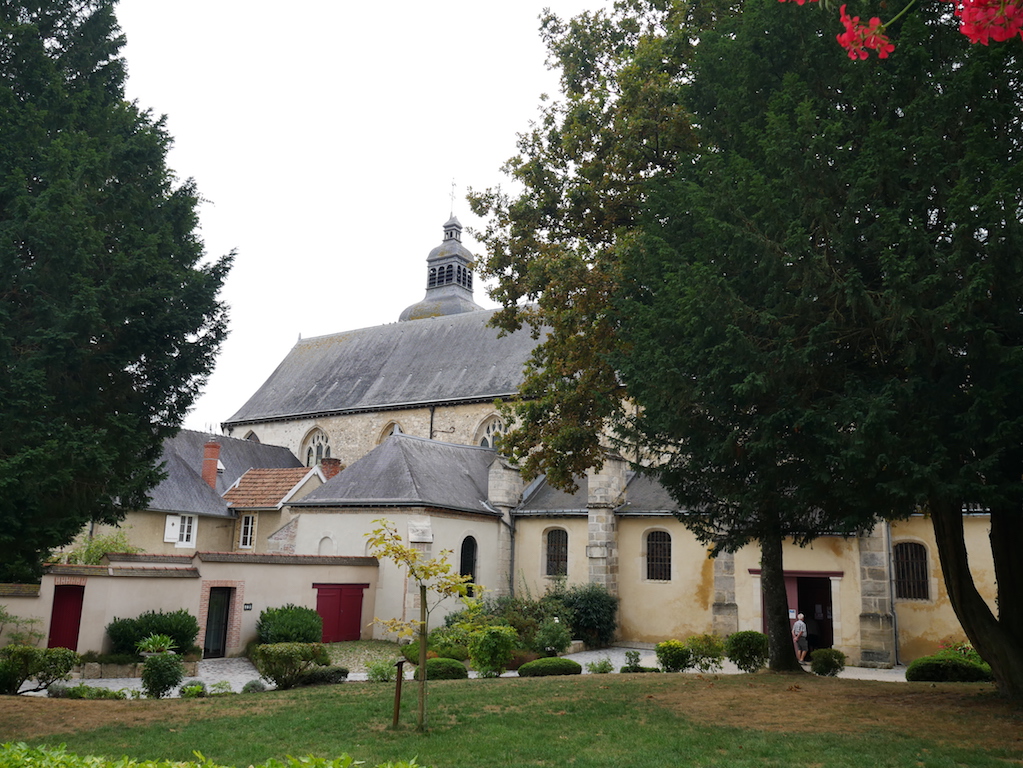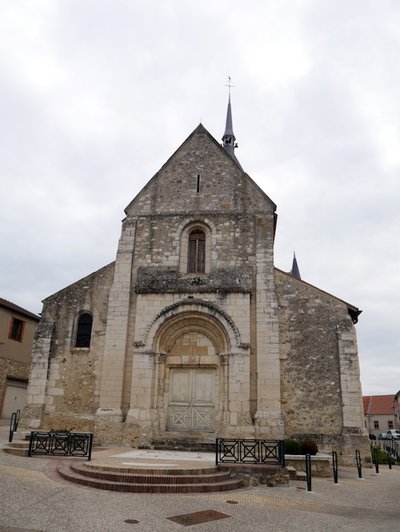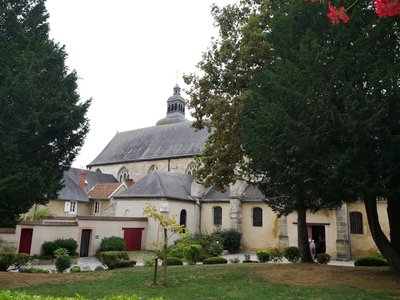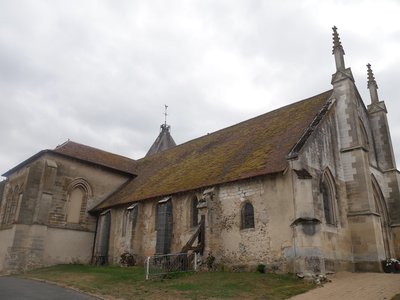Damery to Tours-sur-Marne

Grand Est
13. Damery to Tours-sur-Marne
Medium
6h30
24,7km
+481m
-484m
Step
Embed this item to access it offline
One of the most beautiful stages of the Via Columbani. The atmosphere of the wine-growing landscapes crossed will transport you into this world of bubbles and glitter far from the monastic austerity. Then you will find the banks of the Marne with its Champagne villages.
7 points of interest

Église Saint-Georges, Damery - Amis de saint Colomban TouristSt. George's Church was the seat of a priory between the 12th and 16th centuries.
Damery's land was part of the royal estate. A diploma from 870 indicates that Damery's villa was given to the Benedictines of the Abbey of Saint-Médard de Soissons.
A church existed at the beginning of the 12th century because in 1101 a conflict arose over the altar of Damery's church. Indeed the bishop of Soissons, Hugues de Pierrefonds, offered the altar to the chapter of the cathedral of Soissons. The altar was finally returned to the abbot of Saint-Médard de Soissons.
Les parcelles du vignoble champenois - Amis saint Colomban PanoramicChampagne vineyards in the Marne valley
The vineyards of the Marne Valley originate on one side, in Tours-sur-Marne, opposite the spur of Bouzy on the last mounds which limit the plain of the Champagne Pouilleuse, and on the other side, in Épernay, develops towards Paris on both banks of the river, but mainly on the right bank and with a south and south-east exposure.
It flows down all along the spread out slopes that follow the meanders of the Marne, sometimes coming closer as if to reflect in its greenish waters, sometimes moving away from them to nestle at the bottom of small picturesque cirques.
Among all the vintages, Aÿ is the grand sire and Mareuil its first lord. The Pinot noir, with its variety the golden green Pinot, gives remarkable wines. Very full-bodied, with a delicate bouquet, less fresh than those from the mountains of Reims, they bring body and finesse to the blends.
It is in Hautvillers, the cradle of champagne, with its marvellous site, that Dom Pérignon, cellarer of the abbey that has remained famous, is said to have discovered the art of champagne preparation. There, Pinot Noir is accompanied by Miller, as in Dizy, Champillon and Cumières, but beyond and on both sides of the river, there are secondary growths made exclusively from Miller grapes, whose less full-bodied and fresher wines are sought after to balance the cuvées.
The region of Epernay includes two series of vineyard slopes planted with Meunier; one stretches from Epernay to Ablois via Pierry, the other starts in Brugny-Vaudancourt and ends in Mancy, forming an arc of a circle with steep slopes.
This picturesque region produces wines that are quite full-bodied and of a particular freshness, making them sought after in blends.
Église abbatiale Saint-Pierre, devenue église paroissiale Saint-Sindulphe - Amis saint Colomban St ColumbanSaint-Pierre d'Hautvillers Abbey
Around 665, the bishop of Reims Nivard consecrated a monastery on the lands of the mountain of Reims with the agreement of King Childeric II. He will appoint the monk Berchaire to organize the community. Berchaire, originally from Aquitaine, followed his monastic training in Luxeuil. His experience of the rule of life of the Luxeuil monks will be applied from the foundation. This Luxovian rule of life was a mixture of the rules of Benedict of Nursia and Saint Colomban which complemented each other.
Berchaire left Hautvillers to found the monasteries of Montier-en-Der and Puellemontier.
The abbey prospered in spite of the vicissitudes of history: destroyed by the Normans in 882, restored then burnt down by the English in 1449, rebuilt then razed to the ground by the Huguenots in 1564. It will rise again from its ashes thanks to the donations of Catherine de Medici. It definitively ceased all activity during the Revolution. Following the revolts of the time, only the abbey church and a small part of the cloister remain. Today the monastery buildings are the property of a Champagne brand for private receptions. The most famous of the monks of this abbey is undoubtedly Dom Pérignon who invented the Champagne method for the fermentation of wine.
The abbey church of Saint-Sindulphe, a 4th century hermit whose relics were transported to the church in the 9th century, houses the relics of Saint-Nivard, Saint Helene and Dom Pérignon.
The present church dates from the 16th century and succeeds three other buildings. It is visited by many tourists from all over the world who come to thank Dom Pérignon for his famous discovery.
More information Wikipedia
Église Saint-Brice d’Ay - Amis saint Colomban TouristSaint-Brice Church in Ay
The church of St. Brice d'Ay is a Gothic church from the 15th century. The bell tower is from the 16th century.
It has a large French Baroque organ dating from 1749 which was restored in 1991.
Ay, Maison ayant abrité le pressoir du roi Henri IV - Amis saint Colomban TouristÄy wine
Ay's red wines were the most famous in France: Pope Leo X, Emperor Charles V, Francis I and Charles X... It is said that the wine of Ay had supplanted the wines of Burgundy at the table of King Henry IV and the latter had his own wine press in Ay. At the end of the 17th century the people of Champagne produced white wine by slowly pressing white and black grapes. Until that time the wine was not sparkling. Then the winegrowers learned how to blend several wines and mastered the effervescence in the 18th century. The famous master glassmaker René Lalique was born in Ay. A tour through the city pays homage to him
More information Wikipedia
Église Saint-Hilaire de Mareuil-sur-Aÿ - Amis saint Colomban HistoricalMareuil-sur-Ay
In the 10th century, the Sire de Coucy had a castle built on an island in the Marne. A village was born on the right bank of the Marne which developed over the centuries. The Saint-Hilaire church (11th century) has kept its Romanesque bell tower.
Today the vine and the Champagne trade are the main activities of the town. The castle of Montebello (private property) built in the 18th century dominates the town.
Église Saint-Hélain de Bisseuil - Amis saint Colomban St ColumbanSaint-Hélain Church in Bisseuil
According to hagiographic tradition, Saint-Hélain would be a brother of Saint Gibrien of Châlons-en-Champagne. Although the lives of these saints were written several centuries after their deaths, worship and pilgrimages have existed since the Middle Ages. Their Irish origins remain attached to this local tradition.
It would be buried in Bisseuil is a church built in the 13th century and rebuilt in the 15th century, classified as a historic monument. Of the 13th century building, only the north transept remains. The present bell tower was built after the fires of the 18th century. In the 19th century, the west facade was restored.
Description
Leave the Damery church by turning left in front of the choir, rue Paul Douce, straight ahead at the roundabout pass in front of the town hall.
- Turn right, cross the parking lot and take the Adrienne Lecouvreur alley. Turn left into the rue de Romery then take the first vineyard path on the right, stay on the main path after 400 meters cross the crossroads. The path slopes to the right.
- At the crossroads turn right and then immediately left. After 100 meters take the path on the right up to the crossroads turn left, stay on the main path until the edge of the wood turn right. Follow the edge of the wood to go around the forest for 2,200 metres.
- Take the path on the right that crosses the vineyard parallel to the forest up to the Hautvillers Abbey Park, on the left in the Rue de l'Aubrois.
- Take the street on the right and pass coming from the church, on the left rue des Cumières then rue Bacchus, rue d'Eguisheim, rue de la Fontaine aux Frênes, go along the pond to take the path straight into the forest. Take the first road on the right up to the D 951.
- Cross the D 951 straight on to join the vineyard path and enter Champillon by the rue de la République. Turn right on rue René Baudet until the crossroads and take the second left on rue Pasteur.
- At the crossroads in rue Jean Jaurès cross rue Chamisso, turn left into rue du Bel Air then right into Allée des Pins until you reach the last house on your right which you will pass just a few metres before entering the woods in the direction of La Malmaison.
- Cross the Malmaison and before entering the forest turn right (signpost direction Ay) at the exit of the forest take the roads leading to Ay on your left.
- Enter Ay by heading towards the Marne canal, via rue Gambetta, left rue Jules Blondeau, right rue du Prêche, then left to follow the canal. Take the bridge to cross the canal then turn left to follow the canal Chemin des Cavaliers staying along the canal you arrive in Tours-sur-Marne. Take the bridge on the left then on the right, rue du pont, quai du canal, fourth street on the left you arrive at the church of Tours-sur-Marne.
- Departure : Saint-Georges Church, 1 Place de l'Église, 51 480 Damery.
- Arrival : Sainte Madeleine Church, Place de l’Église, 51 150 Tours sur-Marne
- Towns crossed : Grand Est
Altimetric profile
Report a problem or an error
If you have found an error on this page or if you have noticed any problems during your hike, please report them to us here:




